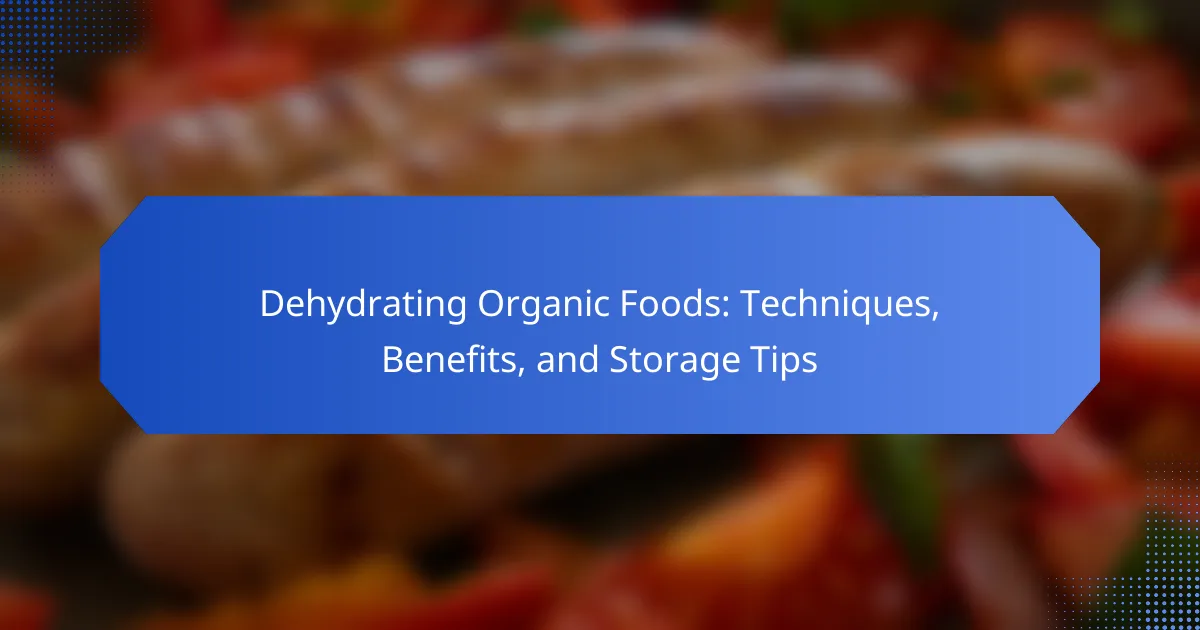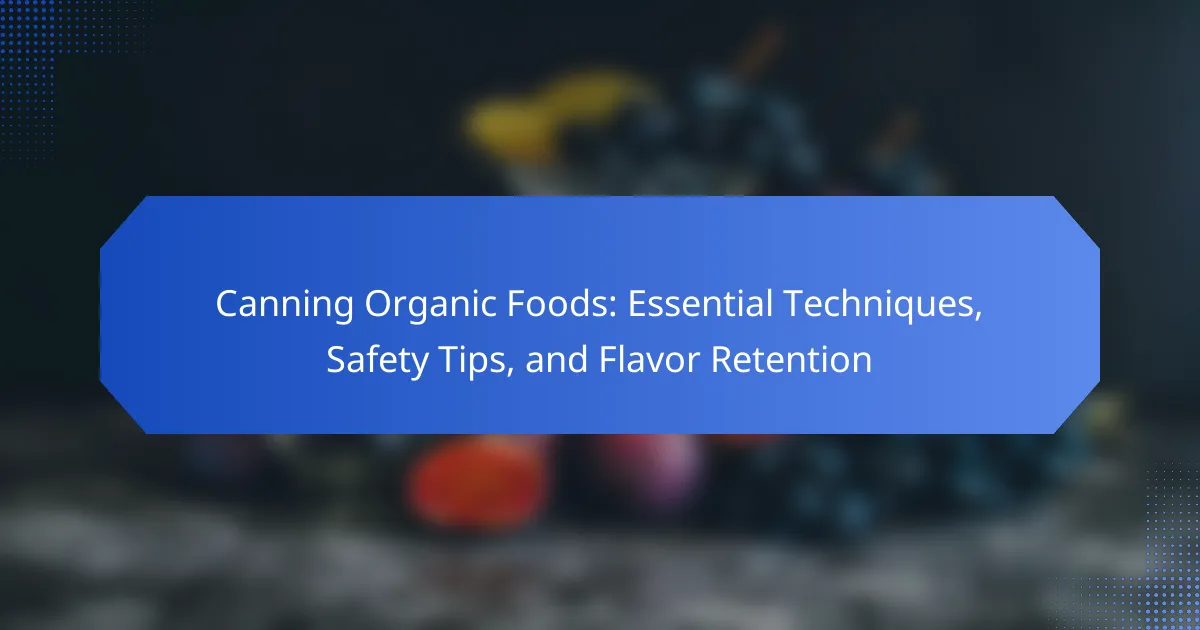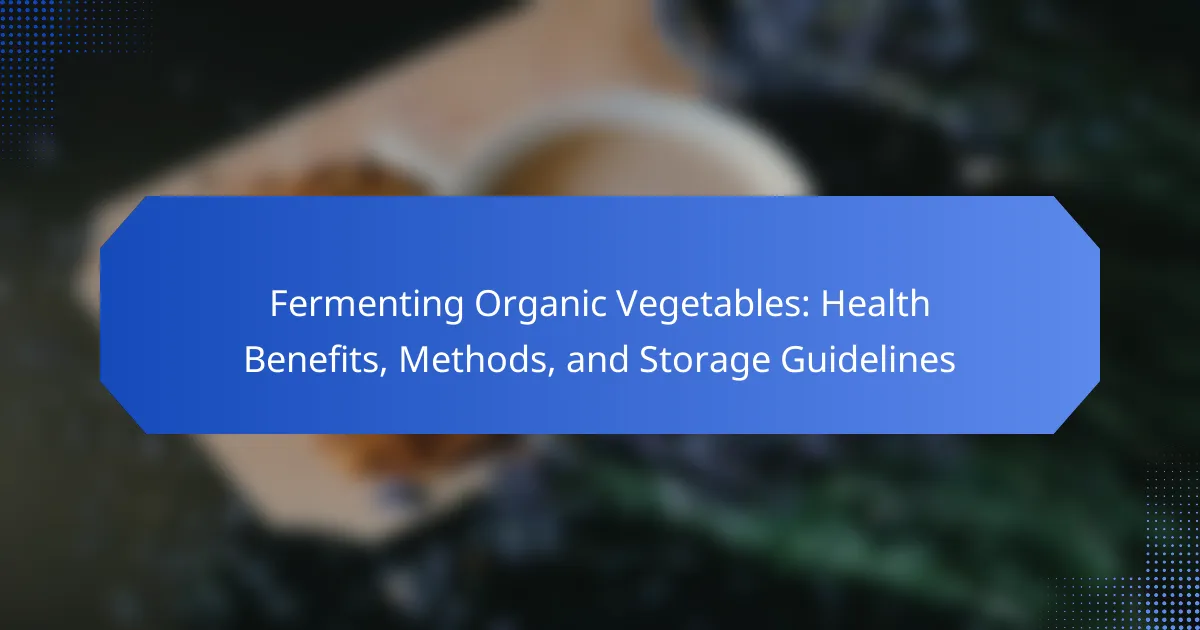Freezing organic produce is a preservation method that involves lowering the temperature of fruits and vegetables to below freezing, which helps maintain their quality, flavor, and nutritional value. This article covers the best practices for freezing organic produce, including selecting fresh items, washing, and blanching vegetables to enhance nutrient retention. It highlights the importance of cooling blanched produce quickly, using airtight packaging to prevent freezer burn, and labeling containers for effective storage management. Additionally, the article discusses the benefits of blanching in preserving vitamins and minerals, emphasizing that freezing promptly after blanching maximizes nutritional quality. Overall, it provides a comprehensive guide to effectively extending the shelf life of organic produce while retaining its health benefits.
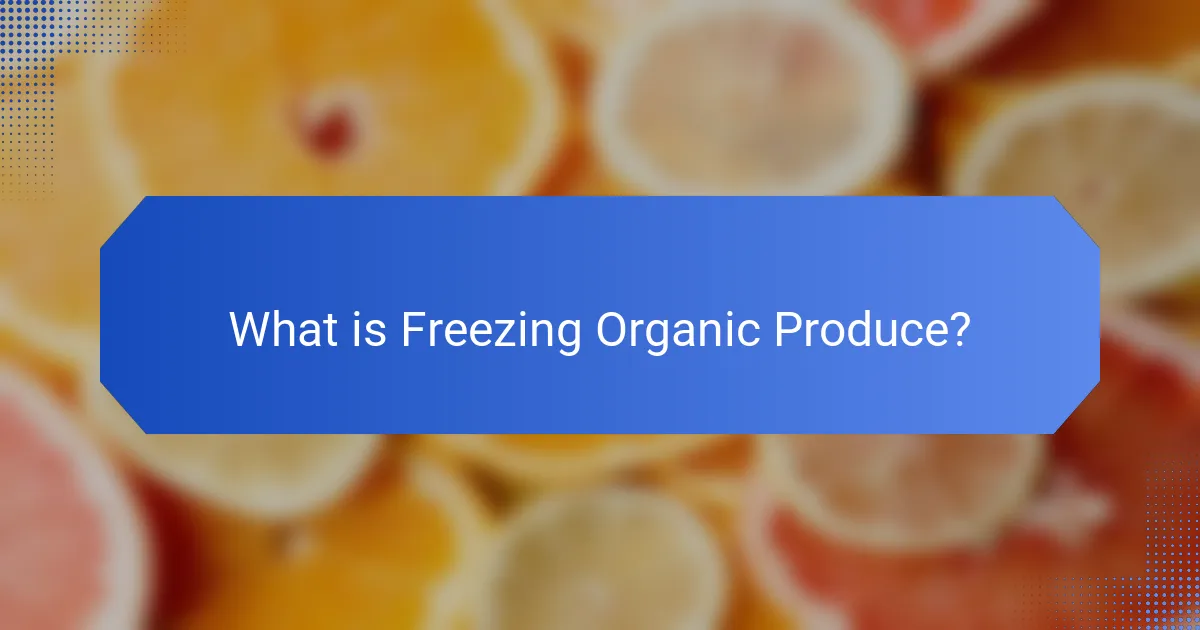
What is Freezing Organic Produce?
Freezing organic produce is the process of preserving fruits and vegetables by lowering their temperature to below freezing. This method helps to maintain the quality, flavor, and nutritional value of the produce. When organic produce is frozen promptly after harvest, it retains more nutrients compared to other preservation methods. Studies show that freezing can preserve vitamins and minerals effectively, particularly when the produce is blanched before freezing. The process halts enzyme activity, which can lead to spoilage. Proper packaging is essential to prevent freezer burn and maintain texture. Overall, freezing is a practical way to extend the shelf life of organic produce while retaining its health benefits.
How does the freezing process impact organic produce?
Freezing organic produce preserves its freshness and nutritional value. The process slows down enzyme activity, which can lead to spoilage. This preservation method retains vitamins and minerals effectively. Studies show that frozen fruits and vegetables can have comparable nutrient levels to fresh ones. For example, a study published in the Journal of Food Science found minimal loss of vitamin C in frozen organic strawberries. Additionally, freezing prevents the growth of microorganisms that cause decay. However, the texture of some produce may change after freezing, becoming softer upon thawing. Overall, freezing is an effective method for maintaining the quality of organic produce.
What are the key steps involved in freezing organic produce?
The key steps involved in freezing organic produce include selecting, washing, blanching, cooling, packing, and freezing. First, select fresh, ripe organic produce. This ensures optimal flavor and nutritional value. Next, wash the produce thoroughly to remove dirt and pesticides. Blanching is crucial; it involves briefly boiling the produce and then plunging it into ice water. This process preserves color, texture, and nutrients. After cooling, drain the produce well. Pack it in airtight containers or freezer bags to prevent freezer burn. Finally, label the packages with the date and freeze immediately. These steps help maintain the quality of organic produce during storage.
What are the differences between freezing and other preservation methods?
Freezing is a preservation method that involves lowering the temperature of food to below 32°F (0°C). This process halts microbial growth and enzymatic activity, effectively extending shelf life. Other preservation methods include canning, drying, and refrigeration. Canning uses heat to kill bacteria and seal food in jars, which can alter texture and flavor. Drying removes moisture, which can concentrate flavors but may lead to loss of nutrients. Refrigeration slows spoilage but does not stop it completely, allowing for shorter storage times. Freezing typically retains more nutrients compared to these methods. Studies show that frozen fruits and vegetables can maintain their nutritional value for months, unlike canned or dried counterparts, which may lose vitamins during processing.
Why is freezing a popular method for preserving organic produce?
Freezing is a popular method for preserving organic produce due to its ability to retain nutrients and extend shelf life. This method slows down enzyme activity that can lead to spoilage. Freezing also inhibits the growth of microorganisms, which helps maintain the quality of the produce. Studies show that properly frozen fruits and vegetables can retain up to 90% of their nutrients. The quick freezing process minimizes ice crystal formation, preserving texture and flavor. Additionally, freezing allows for seasonal produce to be enjoyed year-round. This method is convenient and reduces food waste, making it an efficient preservation choice.
What benefits does freezing offer compared to fresh storage?
Freezing offers several benefits compared to fresh storage. It significantly extends the shelf life of organic produce. For instance, frozen fruits and vegetables can last for months or even years, while fresh produce typically spoils within days to weeks. Freezing preserves the nutritional value of foods. Studies show that freezing can maintain vitamins and minerals better than fresh storage, especially when produce is blanched before freezing. Additionally, freezing prevents the growth of bacteria and mold, ensuring food safety. This method retains flavor and texture, often better than fresh produce that may degrade over time. Overall, freezing is a practical solution for long-term food preservation.
How does freezing help in reducing food waste?
Freezing helps in reducing food waste by preserving food for longer periods. It slows down the growth of bacteria, yeasts, and molds that cause spoilage. According to the USDA, freezing can retain the nutritional value of food for months. This method allows consumers to store excess produce instead of discarding it. Studies show that up to 30% of food is wasted due to spoilage. By freezing, individuals can extend the shelf life of fruits and vegetables significantly. This practice reduces the frequency of grocery shopping, minimizing the likelihood of over-purchasing. Overall, freezing is an effective strategy to combat food waste.
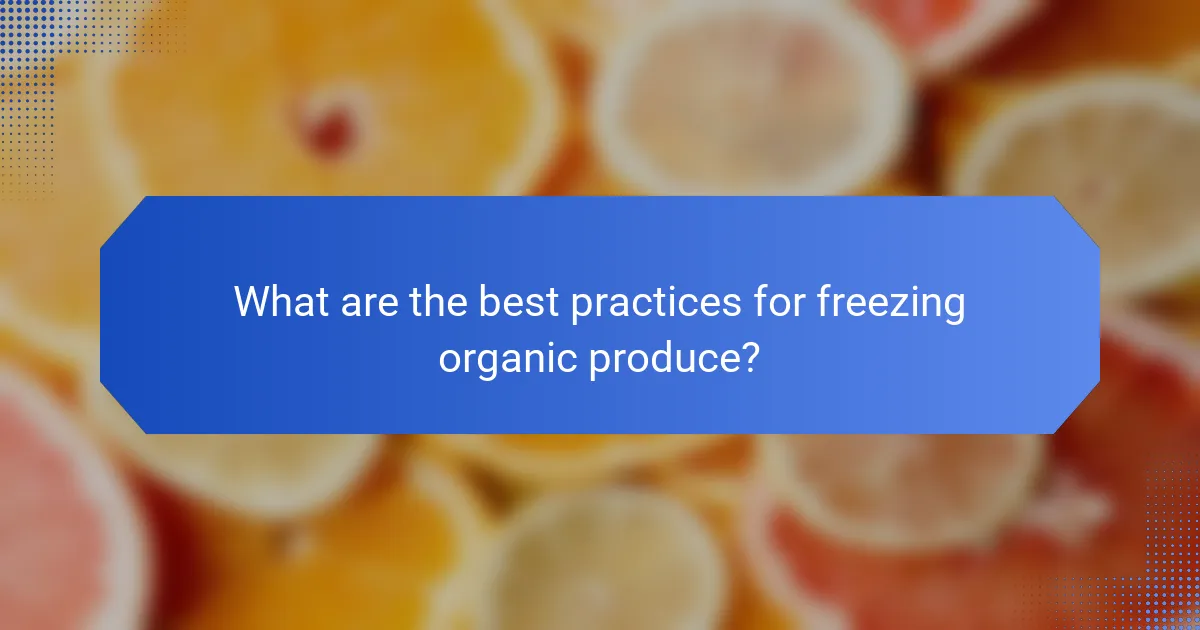
What are the best practices for freezing organic produce?
The best practices for freezing organic produce include selecting fresh, ripe items and washing them thoroughly. Blanching vegetables before freezing helps preserve color, flavor, and nutrients. Cool the blanched produce quickly in ice water to stop the cooking process. Portion the produce into airtight containers or freezer bags to prevent freezer burn. Label each container with the date to monitor storage time. Freeze produce promptly to maintain freshness and quality. Most fruits can be frozen without blanching, but should be cut into smaller pieces for even freezing. Following these practices can help retain the nutritional value of organic produce during storage.
How should organic produce be prepared before freezing?
Organic produce should be washed thoroughly before freezing. Rinse under cold water to remove dirt and pesticides. Cut or chop the produce into desired sizes. Blanching is recommended for most vegetables. Blanching involves boiling briefly and then cooling in ice water. This process preserves color, flavor, and nutrients. After blanching, drain and dry the produce. Pack the produce in airtight containers or freezer bags. Remove as much air as possible to prevent freezer burn. Label the containers with the date for reference.
What techniques ensure optimal texture and flavor retention?
Blanching is a key technique that ensures optimal texture and flavor retention in frozen organic produce. This process involves briefly boiling the produce before rapidly cooling it in ice water. Blanching deactivates enzymes that can cause loss of flavor, color, and texture during freezing. Research indicates that blanching can preserve nutrients and improve the overall quality of frozen vegetables. For example, studies show that properly blanched vegetables retain up to 90% of their vitamins after freezing. Additionally, vacuum sealing before freezing can further enhance texture and flavor retention by minimizing exposure to air.
How does blanching affect the freezing process?
Blanching significantly improves the freezing process by inactivating enzymes that can cause spoilage. This method involves briefly boiling vegetables and then rapidly cooling them in ice water. The process preserves color, texture, and nutritional value during freezing. Studies show that blanching can reduce nutrient loss by up to 50% compared to unblanched produce. Additionally, it helps maintain flavor and prevents off-flavors that can develop during storage. Overall, blanching is essential for high-quality frozen organic produce.
What types of containers are best for freezing organic produce?
The best types of containers for freezing organic produce are airtight plastic bags, glass containers, and freezer-safe plastic containers. Airtight plastic bags prevent freezer burn and are space-efficient. Glass containers are non-toxic and can withstand freezing temperatures. Freezer-safe plastic containers are designed to resist cracking and allow for easy stacking. Each type helps maintain the quality and nutritional value of the organic produce during storage.
What materials are recommended for freezing food safely?
Plastic freezer bags are recommended for freezing food safely. They are designed to prevent freezer burn and moisture loss. Rigid plastic containers are also suitable, as they provide protection against crushing. Glass jars can be used, but they must be tempered to withstand freezing temperatures. Aluminum foil can wrap food tightly, but it is best used in conjunction with another material. Vacuum sealers are effective for removing air, extending food storage life. Each of these materials maintains food quality and safety during freezing.
How can proper sealing techniques improve preservation?
Proper sealing techniques enhance preservation by preventing moisture loss and limiting exposure to air. Effective seals reduce the risk of freezer burn, which can degrade food quality. Vacuum sealing removes air from packaging, significantly extending shelf life. According to the USDA, properly sealed foods can last up to three times longer in the freezer. This method also helps maintain flavor and nutritional value over time. Additionally, airtight seals protect against contamination and odor transfer from other foods. Overall, proper sealing is essential for maximizing the longevity and quality of frozen organic produce.
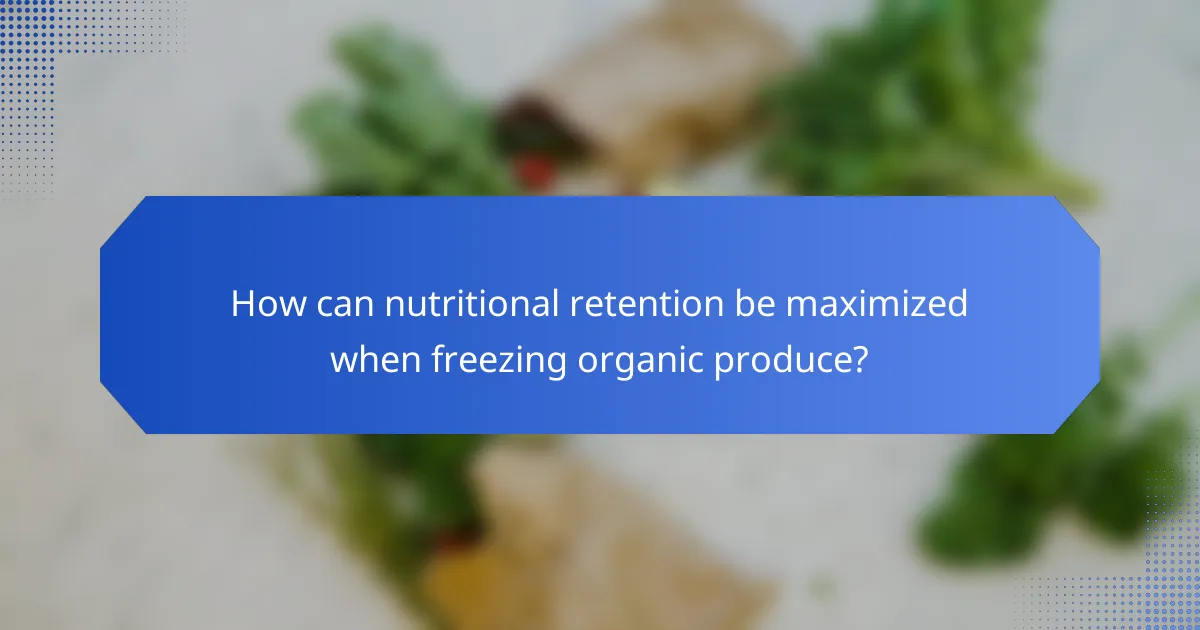
How can nutritional retention be maximized when freezing organic produce?
Blanching organic produce before freezing maximizes nutritional retention. This process involves briefly boiling the produce and then rapidly cooling it in ice water. Blanching inactivates enzymes that cause nutrient loss during storage. It also helps preserve color, flavor, and texture. Studies show that blanched vegetables retain more vitamins compared to unblanched ones. For example, blanched green beans retain up to 90% of their vitamin C after freezing. Freezing promptly after blanching further minimizes nutrient degradation. Vacuum sealing before freezing can also reduce exposure to air, which helps maintain nutritional quality.
What factors influence the nutritional quality of frozen produce?
The nutritional quality of frozen produce is influenced by several factors. These include the timing of harvest, which affects nutrient levels. Produce harvested at peak ripeness generally retains more nutrients. The freezing method used also plays a crucial role. Quick freezing techniques minimize nutrient loss compared to slower methods. Additionally, the duration of storage impacts nutrient retention. Longer storage times can lead to degradation of vitamins and minerals. Temperature stability during storage is another key factor. Fluctuations can negatively affect the quality of frozen produce. Lastly, the type of produce itself matters, as some fruits and vegetables freeze better than others. For example, leafy greens may lose more nutrients compared to berries during freezing.
How does the freezing time affect nutrient retention?
Freezing time significantly affects nutrient retention in organic produce. Longer freezing times can lead to nutrient degradation, particularly of vitamins. Studies show that vitamin C and certain B vitamins are sensitive to prolonged freezing. For instance, a study published in the Journal of Food Science found that freezing fruits and vegetables for extended periods can reduce their vitamin C content by up to 50%. Additionally, the texture and flavor may also deteriorate with extended freezing. Therefore, optimal freezing times are crucial for maintaining nutrient quality in organic produce.
What role does temperature play in preserving nutrients?
Temperature significantly influences the preservation of nutrients in organic produce. High temperatures can lead to nutrient degradation, particularly vitamins such as C and B. Conversely, lower temperatures help maintain nutrient integrity during storage. Freezing slows down enzymatic processes that can cause nutrient loss. Studies show that freezing can retain up to 90% of nutrients in some vegetables. Proper freezing techniques, like blanching before freezing, enhance nutrient preservation. Thus, managing temperature is crucial for maximizing the nutritional value of frozen organic produce.
What specific nutrients are most affected by freezing?
Freezing primarily affects vitamin C, folate, and some B vitamins. Vitamin C is sensitive to temperature changes and can degrade during the freezing process. Folate levels may also decrease due to exposure to cold temperatures. B vitamins, particularly thiamine and riboflavin, can diminish in concentration when frozen. Research indicates that these nutrients can lose 10-50% of their content depending on the freezing duration and temperature.
Which vitamins are sensitive to freezing conditions?
Vitamin C and some B vitamins are sensitive to freezing conditions. Freezing can cause the degradation of these vitamins. For example, vitamin C can lose potency due to freezing and thawing cycles. Research indicates that prolonged exposure to low temperatures can negatively affect vitamin B1 and B6 levels. Studies show that the nutritional quality of fruits and vegetables can diminish when frozen improperly. Maintaining optimal freezing practices can help preserve these sensitive vitamins.
How can one ensure maximum nutrient retention during freezing?
To ensure maximum nutrient retention during freezing, blanching is essential. Blanching involves briefly boiling produce and then rapidly cooling it. This process inactivates enzymes that can cause nutrient loss. For optimal results, blanch vegetables for the recommended time based on their type. For example, green beans should be blanched for about three minutes. After blanching, quickly immerse the produce in ice water to stop the cooking process. This helps maintain color, flavor, and nutrients. Additionally, freezing produce at peak ripeness enhances nutrient content. Proper packaging in airtight containers prevents freezer burn. Studies show that these methods can significantly preserve vitamins and minerals in frozen fruits and vegetables.
What are some common mistakes to avoid when freezing organic produce?
Common mistakes to avoid when freezing organic produce include not washing the produce properly before freezing. Washing removes dirt and potential contaminants that can affect quality. Another mistake is failing to blanch vegetables prior to freezing. Blanching helps preserve color, texture, and nutritional value. Additionally, overpacking freezer bags can lead to uneven freezing. It is important to leave space for air circulation. Not using airtight containers can cause freezer burn, degrading the produce. Lastly, neglecting to label items with dates can result in forgotten produce and waste. Following these guidelines ensures better quality and longevity of frozen organic produce.
How can improper freezing techniques lead to quality loss?
Improper freezing techniques can lead to quality loss by causing cellular damage in organic produce. When produce is frozen too slowly, ice crystals form within the cells. These large ice crystals can rupture cell walls, leading to texture degradation. This results in a mushy consistency upon thawing. Additionally, inadequate freezing temperatures can promote the growth of ice crystals on the surface. This phenomenon, known as freezer burn, affects flavor and nutritional value. Studies show that rapid freezing methods preserve the integrity of produce better than slow methods. Therefore, using proper freezing techniques is crucial for maintaining quality.
What are the signs of improperly frozen organic produce?
Signs of improperly frozen organic produce include freezer burn, discoloration, and mushy texture. Freezer burn occurs when food is exposed to air, resulting in dry, grayish patches. Discoloration may indicate nutrient loss or spoilage. A mushy texture often results from thawing and refreezing, leading to cell damage. Additionally, off-odors can signal spoilage. These signs indicate that the produce may not be safe or nutritious to consume.
What practical tips can help achieve the best results in freezing organic produce?
Select fresh, ripe organic produce for freezing. Wash and dry the items thoroughly to remove dirt and bacteria. Cut larger items into smaller, uniform pieces for even freezing. Blanch vegetables in boiling water for a brief time to preserve color and nutrients. Cool the blanched vegetables quickly in ice water to stop the cooking process. Use airtight containers or freezer bags to prevent freezer burn. Label containers with the date and type of produce for easy identification. Freeze produce in small portions to facilitate quick thawing. These practices help maintain the quality and nutritional value of frozen organic produce.
Freezing organic produce is a preservation method that maintains the quality, flavor, and nutritional value of fruits and vegetables by lowering their temperature below freezing. This process involves key steps such as selecting, washing, blanching, cooling, packing, and freezing, which help retain nutrients and prevent spoilage. The article explores the impact of freezing on organic produce, comparing it to other preservation methods, and emphasizes best practices to maximize nutritional retention. Additionally, it highlights common mistakes to avoid and provides practical tips for achieving optimal results in freezing organic produce.
